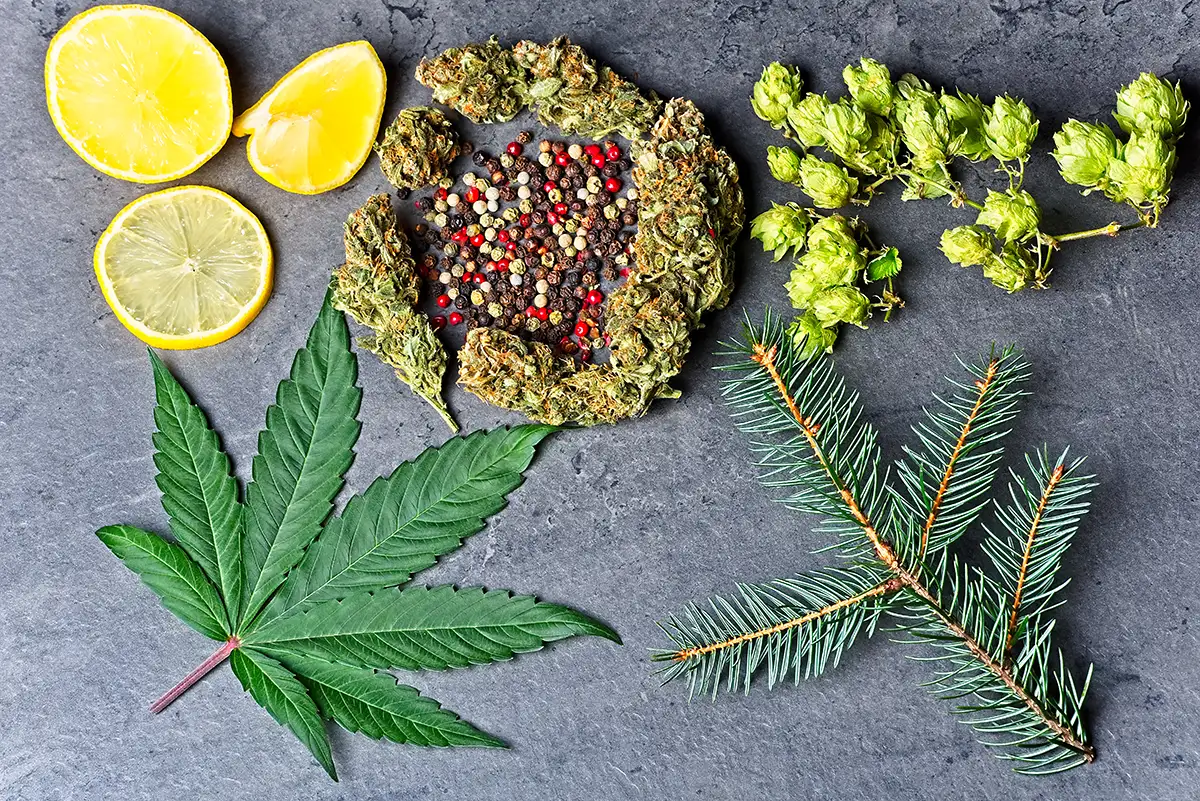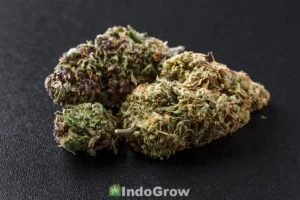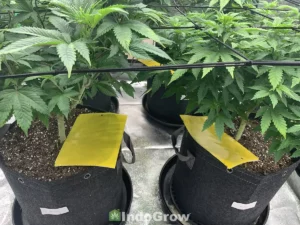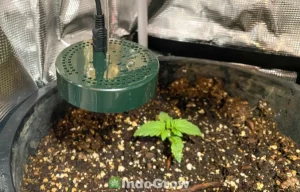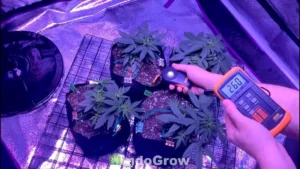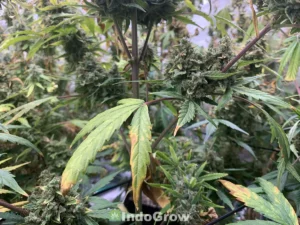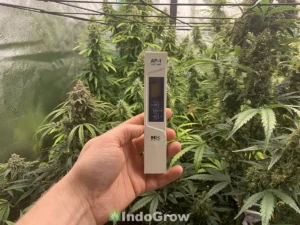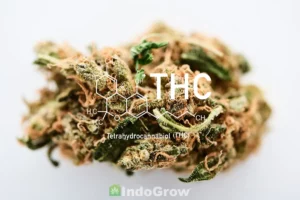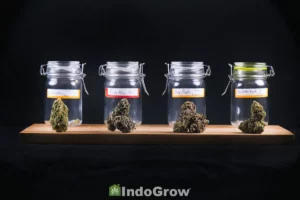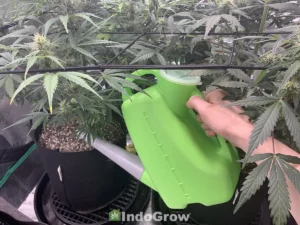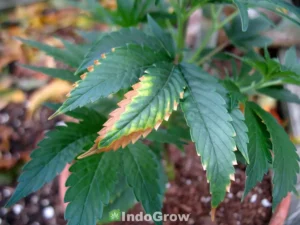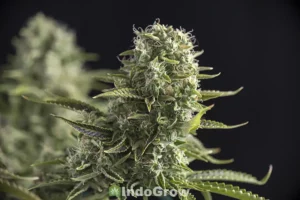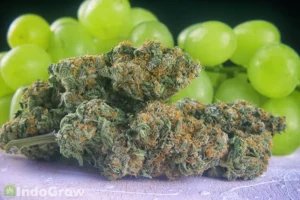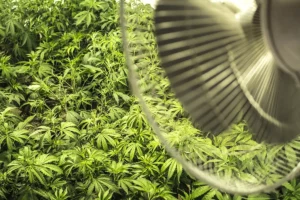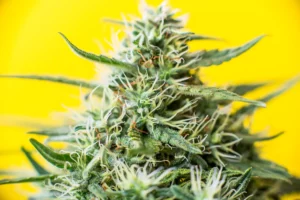While cannabinoids like THC and CBD are the most well known chemical compounds found in cannabis, there are over 200 types of cannabis terpenes also present. These terpenes determine the flavor and scent profile of the flower, and offer wide ranging medicinal benefits. Read on to learn more about common cannabis terpenes and their medicinal values, how to increase terpenes in your cannabis plants, and much more.
Table of Contents
- What are Terpenes in Cannabis?
- Terpenes vs THC vs CBD
- Terpenes and Their Effects
- The Medicinal Benefits of Cannabis Terpenes
- How to Increase Terpenes in Cannabis
- How to Protect Terpenes When Drying, Curing, and Storing Cannabis
- Terpenes in CBD Oil
- Terpene Extraction for Essential Oils
- Buying Terpenes Online
- Conclusion
What are Terpenes in Cannabis?
Cannabis terpenes are natural chemical compounds found in the cannabis plant that affect the flavor and aroma of the plant. While terpenes can be found on the fan and sugar leaves, the highest concentrations of marijuana terpenes are found in the flowers. Cannabis plants originally produced terpenes to attract beneficial insects while deterring predators who did not like their scent.
Growers and buyers of cannabis often pay close attention to the terpene profile of their cannabis. Different cannabis terpenes may give the flower a more spicy, herbal, citrus, fruity, or other scent. Some terpenes can also provide therapeutic effects or subtly affect your high.
Terpenes vs THC vs CBD
Terpenes are sometimes confused with the more well known cannabis compounds THC and CBD. THC and CBD are both cannabinoids, which are potentially psychoactive compounds that interact with human cannabinoid receptors to produce changes in the body. Cannabinoids such as THC and CBD are unique to cannabis plants, but they do not have a flavor or scent.
In contrast, terpenes are a group of aromatic unsaturated hydrocarbons secreted by the cannabis plant’s trichomes. Terpenes are found in a huge range of plants, although they are particularly concentrated in certain groups such as conifers, citrus, and cannabis. Terpenes have strong, typically pleasant aromas, and they are a primary ingredient in many essential oil blends. Although weed terpenes won’t get you high like cannabinoids, many terpenes are believed to have other beneficial effects on the body such as reducing inflammation or producing feelings of relaxation.
Terpenes and Their Effects
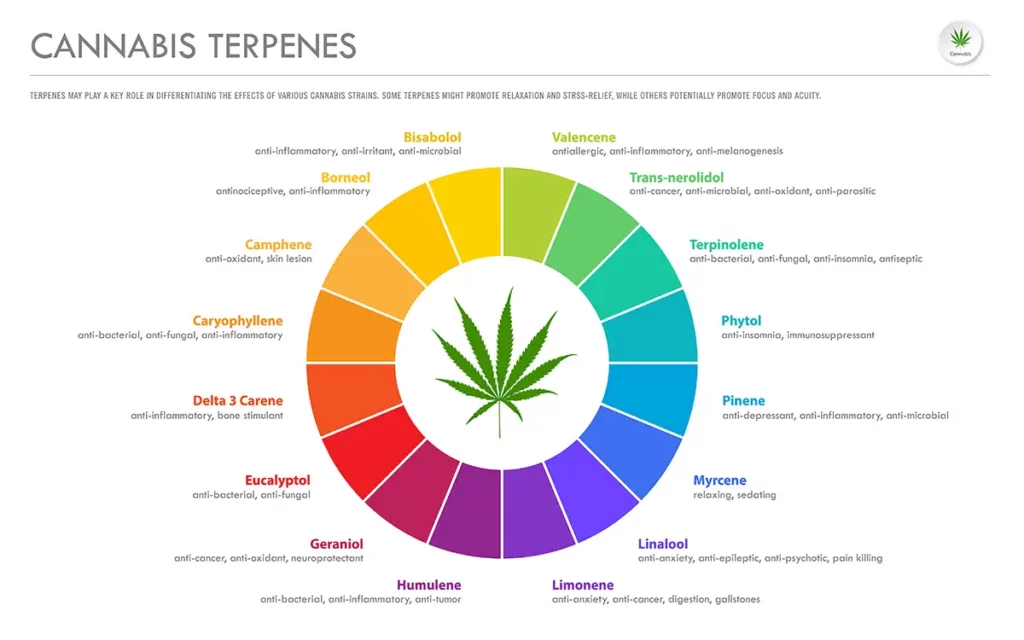
While over 200 individual terpenes can be found in cannabis, the most common marijuana terpenes include Myrcene, Limonene, Pinene, Caryophyllene, Linalool, and Humulene. This section will take an in depth look at these 6 terpenes commonly found in cannabis, including their flavor, aroma, medicinal uses, sample strains, and more.
Myrcene
Myrcene is the most abundant terpene in commercial cannabis production, representing about 20% of the overall terpene profile of commercially available strains. Myrcene is also the most common “dominant” terpene, meaning that it is the terpene found in the highest concentration in a particular cannabis strain. About 40% of commercially available strains are Myrcene dominant.
Myrcene has a spicy, peppery, and earthy aroma. It is found in a wide variety of culinary and medicinal plants including thyme, basil, cardamom, cloves, black pepper, mangoes, lemongrass, and hops.
In high enough concentrations, myrcene may increase feelings of relaxation and sedation. Myrcene rich plants such as lemongrass and hops have been used in folk medicine for centuries, but large scale modern studies have yet to fully explore the medicinal benefits of myrcene.
With the abundance of myrcene dominant strains on the market today, you will likely have little trouble finding a strain high in myrcene. High myrcene strains include Granddaddy purple, OG Kush, Blue Dream, Mango Kush, Bubba Kush, and many more.
Limonene
Limonene has a bright, citrusy and floral aroma that makes it a popular dominant terpene in many fruit or citrus themed strains. As the name might suggest, limonene is found in high concentrations in many citrus fruits including lemon, lime, grapefruit, and orange. Although it is most commonly associated with citrus, limonene can also be found in the sap of many other trees including red and silver maples, sumac, spruce, pines, firs, and more.
In addition to its pleasant aroma, limonene is believed to be a potent antioxidant and mood booster. Research in mice suggests that limonene may be able to bind to certain receptors in the brain to reduce stress. Because of these medicinal benefits, citrus essence has been used in aromatherapy for many years.
D-limonene, the limonene isomer most common in cannabis, is also a popular household cleaner. Limonene extract can be used in place of isopropyl alcohol to clean resin off of pipes or other surfaces, and it has the added benefit of leaving a pleasant citrus scent behind.
Strains high in limonene include Durban Poison, Berry White, Black Cherry Soda, Lemon Diesel, Super Lemon Haze, and more. Note that not every strain with lemon in the name is actually limonene dominant, so do your research before purchase if you are looking for a high limonene strain.
Although D-Limonene is the most common type of limonene in cannabis, a few strains such as Sour Diesel actually contain significant amounts of L-Limonene. This isomer has a more piney, chemical scent often compared to turpentine.
Pinene
Pinene is the most common terpene in the natural world, likely because this terpene is a strong insect repellent. This terpene has an earthy, minty, and herbal smell reminiscent of pine needles or pine sap. Pinene is produced in large concentrations by conifers, and it can also be found in many culinary plants including rosemary, parsley, basil, sage, oregano, and chamomile. Pinene has several isomers, with Alpha-Pinene being the most common in cannabis.
Similar to Limonene, pinene may have anti anxiety and antioxidant properties, although more research will be needed to confirm this. Pinene is also believed to have anti-inflammatory properties, and it may function as a bronchodilator (opening airways) or an analgesic (painkiller) as well.
Pinene rarely appears as the dominant terpene in cannabis strains, more commonly being found alongside other terpenes including myrcene and caryophyllene. Strains high in pinene include Limoncello, Big Smooth, Cherry Gelato, Blue Dream, Critical Mass, and more.
Caryophyllene
Caryophyllene, or more specifically beta-caryophyllene, is the second most common cannabis terpene after Myrcene. Caryophyllene has a peppery, spicy flavor, and can be found in sizable concentrations in black pepper, cloves, cinnamon, basil, caraway, and hops.
Caryophyllene is the only terpene known to directly interact with the endocannabinoid system. It has been found to bind to CB2 receptors in mouse subjects, the same receptors targeted by CBD and some other cannabinoids. Due to this unusual trait, caryophyllene has been the subject of greater interest and scientific research than many other marijuana terpenes.
Caryophyllene is believed to boost mood, support immune function, and reduce pain and inflammation. Because caryophyllene is generally regarded as safe to consume in large quantities, this terpene is gaining popularity as a dietary supplement.
Strains with high levels of Caryophyllene include Bubba Kush, Sour Diesel, Chemdog, Wedding Cake, Gelato, Original Glue, Zkittlez, and more.
Linalool
Similar to pinene, linalool is an abundant terpene in nature, found in over 200 types of plant. Linalool has a floral, lavender like scent, and can be found in a variety of herbs and fruits including lavender, rose, laurel, guava, plum, passionfruit, and many more.
Linalool is believed to have antimicrobial, immune boosting, sedative, pain relieving, and stress relieving properties. Linalool in the form of lavender and other plants has been used in traditional medicine for centuries for relaxation, pain relief, and assistance in fighting infections.
Strains with high Linalool concentrations include Granddaddy Purple, Mazar I Sharif, Red Haze, Durban, Do Si Dos, Lavender, and more. Linalool tends to be more common in indica strains, although some sativas such as Red Haze also have significant quantities of Linalool.
Humulene
Humulene, also known as alpha-humulene or alpha-caryophyllene, is a hoppy, pungent terpene also found in plants such as hops, cloves, sage, and ginseng. This terpene is found in many strains of cannabis, though not in large quantities. It is often found in the same plants as its isomer beta-caryophyllene.
Humulene containing plants such as ginger, ginseng, and chinese laurel are used widely in eastern medicine, and humulene itself is believed to have a wide range of beneficial effects including anti-inflammatory, antimicrobial, antitumor, antibacterial, and analgesic properties. Because humulene is also believed to be an appetite suppressant, strains high in humulene may be less likely to cause the munchies.
Strains with high concentrations of humulene include White Widow, Super Sour Diesel, Girl Scout Cookies, Super Lemon Haze, Headband, and more.
The Medicinal Benefits of Cannabis Terpenes
Besides adding scent and flavor to the cannabis plant, cannabis terpenes may provide a wide range of medicinal benefits. This section will cover some of the major positive health effects of terpenes, and which terpenes to focus on to maximize those benefits. Terpenes often work in concert with one another, so consuming mixed blends of cannabis terpenes may be more effective for a particular condition than taking an isolated terpene.
Pain Relief
Many terpenes are believed to have analgesic, or pain relieving properties. Popular weed terpenes for pain relief include beta-caryophyllene, humulene, and pinene. These terpenes can be consumed as part of a whole plant therapy, or taken orally or as a vapor in extract form.
While the three terpenes mentioned above are believed to have inherent analgesic properties, some other terpenes such as myrcene are believed to enhance the pain relieving effects of cannabinoids like THC.
Antiviral
An increasing body of research is investigating the antiviral properties of different terpenes. Weed terpenes in combination with CBD have demonstrated an ability to protect cells from viral attack in lab conditions. However, the extent of their ability to fight viruses in the body is not yet known.
Anticancer
Both cannabinoids and cannabis terpenes have demonstrated some interesting anticancer effects in lab studies, including causing oxidative stress to cancer cells and shrinking the mass of tumors. Alpha-Pinene, alpha-humulene, and d-limonene have shown particular promise in preventing and slowing the spread of cancerous cells in rodent subjects.
Antidepressant
Some weed terpenes are believed to have a modest antidepressant or antianxiety effect on their own, such as myrcene and linalool. However, most terpenes appear to be more effective at elevating mood when combined with other terpenes and cannabinoids, a phenomenon sometimes referred to as the “entourage effect”. For this reason, whole plant extracts tend to be more effective as antidepressants than any individual terpene.
Antimicrobial
A large body of research has supported the idea that many terpenes have potent antimicrobial qualities, particularly in their oxygenated terpenoid form. Among marijuana terpenes, alpha-pinene has shown the most consistent antimicrobial properties, although d-limonene, myrcene, linalool, and some others also display antimicrobial activity.
Because of their ability to inhibit bacterial and fungal growth, the presence of terpenes likely protects cannabis plants during flowering, and extends their shelf life after harvest. In humans, taking terpene supplements alongside conventional antibiotic or antifungal medications may improve recovery time. However, you should always consult your doctor before taking terpene supplements as concentrated terpenes may cause side effects or have unwanted interactions with your medication.
How to Increase Terpenes in Cannabis
If you are looking to increase the quantity of terpenes in your cannabis, strategies such as choosing strains based on their terpene profiles, optimizing light levels, adding UV light, optimizing temperature during flowering, and adding terpene enhancing nutrients can help.
Before you begin growing, do some research on what terpenes you are most interested in, and select a strain that is known to be high in those terpenes. Some strains may naturally produce more terpenes than others, so look for reviews indicating that the strain is sticky and aromatic.
Optimizing your light levels during each stage of development will also help increase the quantity of terpenes in your cannabis. Look for lights with a minimum of 500 PPFD during the vegetative stage and a minimum of 900 PPFD during the flowering stage. While plants will survive and flower at lower light levels, they will not receive enough photosynthetic energy to focus on both leafy growth and terpene production.
Besides selecting high output grow lights, consider adding supplemental UV lights to your grow. LED lights give off very little UV light on their own, but many grow light sellers now offer UV lights that can be used in concert with their standard grow lights.
While excessive UV light could harm the plant, low levels will encourage the plant to produce terpene rich oils that provide a protective barrier from the UV radiation. To some growers, intentionally exposing their plants to a stressor like UV radiation may sound counterintuitive. However, cannabis plants have evolved to protect themselves from the strong UV radiation of the sun, so adding UV to indoor grows actually mimics their natural lighting conditions more closely than using grow lights alone.
Another simple method of increasing terpene production is lowering grow room temperatures during the last week or so of flowering. Dropping temperature by 5-10 degrees will signal to the plant that its growing season is coming to an end, encouraging it to put a final burst of energy into its flowers.
Finally, consider adding terpene enhancing nutrients such as Terpinator. Terpinator is a 0-0-4 nutrient formula that increases potassium and other micronutrients used by the cannabis plant to produce terpenes.
How to Protect Terpenes When Drying, Curing, and Storing Cannabis
During the drying stage, dry your cannabis in a dark room with around 60% humidity and temperatures between 60-70 degrees F. Dry for approximately 4-10 days, until the small stems are brittle and snap off easily. Exposure to too much heat or light can degrade terpenes, so do not attempt to rush the drying process.
Once drying is complete, move the buds into a wide mouth mason jar and add Boveda 62% humidity packs to keep the humidity inside the jar close to 60%. Store the jars in a cool dark location such as a cupboard or closet.
During the first week, jars will need to be burped daily to allow fresh air in and release gas built up from the curing process. Gradually increase time between burpings over the next couple weeks until curing is complete.
For long term storage, continue to keep the jars in a cool, dark location with humidity packs. As long as the buds are protected from heat, improper humidity, and direct sunlight, their terpenes should be preserved for months or even years.
Terpenes in CBD Oil
Many CBD oils do not list a terpene profile, so finding CBD extracts containing specific terpenes can prove difficult. When comparing CBD options, look for those labeled full spectrum or broad spectrum, as these extracts are made using the entire cannabis flower and will contain a variety of cannabis terpenes. In contrast, pure CBD extracts will have only CBD suspended in oil, with other cannabinoids and terpenes being filtered out during the extraction process.
Similar to cannabis flower, you can expect to find some combination of Myrcene, Caryophyllene, Pinene, Linalool, Limonene, and Humulene in full spectrum CBD oils, along with a variety of other minor terpenes. These terpenes may enhance the relaxing, pain relieving, and other medicinal properties of CBD compared to pure CBD oil.
Terpene Extraction for Essential Oils
Terpenes are typically extracted from cannabis flowers using either CO2 extraction or steam distillation. In steam distillation, steam is used to carry the terpenes off the plant matter, where they are later cooled and collected. In CO2 extraction, terpenes are first dissolved in a hydrocarbon solvent such as hexane, then CO2 chambers with varying pressure and heat are used to extract the terpenes.
Steam distillation is popular with essential oil producers as it is relatively simple and an excellent way to capture hydrocarbon terpenes such as beta-caryophyllene and myrcene. Although CO2 extraction can be more complicated and costly to set up, it can extract a broader range of terpenes, and can also be used to extract cannabinoids and other substances along with the terpenes.
Buying Terpenes Online
Because terpenes do not contain THC, they can be legally purchased online and shipped throughout the US. As our understanding of the medicinal benefits of terpenes grows, more people are interested in taking them as nutritional supplements. A variety of American companies now offer both pure terpene extracts and terpene blends.
When you order terpenes online, try to purchase from a GMP certified facility based in the USA. Because the nutritional supplement market is not tightly regulated by the FDA, buying from a GMP certified facility will give you the peace of mind that you are buying from a company that meets FDA manufacturing standards. Reputable companies should also display third party batch analyses of their products, which will show exactly what compounds are in the extract and in what quantities.
Conclusion
Terpenes are a fascinating group of natural compounds that give cannabis its distinctive flavor and aroma. Besides adding a wide array of flavors to your buds, terpenes are believed to provide a wide range of medicinal benefits including antimicrobial, antianxiety, anticancer, anti-inflammatory, and more. Terpenes can be enjoyed as part of the natural cannabis flower or in extract form for more specific medicating.

Rocky Horton
Author
Rocky Horton is an experienced cannabis grower and the founder of IndoGrow. The IndoGrow editorial team has over four decades of combined growing experience. Learn more.

